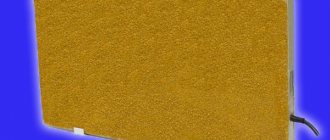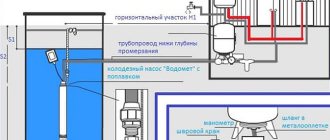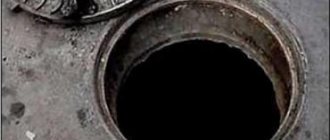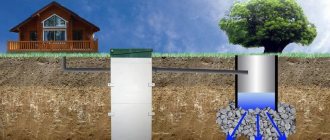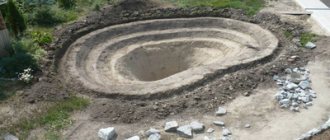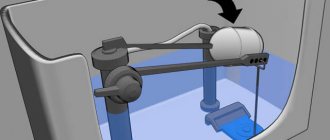A well at a summer cottage, like any other hydraulic structure, gradually exhausts itself in terms of supplying the required volume of water. And this becomes the reason that the owner of the site begins to think about how to fill up the well, how to carry out this process with minimal costs. By the way, it should be noted that besides this reason there are others. For example, partial or complete destruction of the shaft, littering the mine, and so on. That is, the technical condition of the tank becomes unsuitable for its operation.
An old well is a dangerous place
And the open neck of an unused well is a dangerous place where children or pets can fall. Of course, you can get by with little money by installing a durable cover made of thick sheet metal or reinforced concrete on the head. But, as practice shows, owners of suburban areas are not satisfied with this temporary measure. Everyone is trying to backfill the well. Therefore, let's look at how to do it correctly.
First, it should be noted that filling wells is much easier than building them. But it is necessary to take into account some points when carrying out liquidation work. Let us denote their general list.
- If the water level inside the old well is high enough, then when filling it, it is necessary to take measures to eliminate its spill so as not to flood the area. Therefore, it is best to first pump out all the water and then backfill.
- It is clear that after filling the well, a new one will be built or a well will be drilled. So, when dismantling an old structure, it is very important not to spoil the aquifer as a whole.
- There is no point in removing the bottom filter, because this is the basis for the material poured inside. If it is not there, then there is a high probability that the backfill will be washed away and shrink.
- If during the rainy season and snow melting the rise in groundwater is quite large, then it is necessary to consider ways to waterproof the old well from the outside. If this is not done, then subsidence of the soil near the well may occur. If waterproofing is difficult, you can install a drainage system.
Dirt, turbidity and rotten water inside a hydraulic structure
What is quicksand and why is it dangerous?
Quicksand in a well is a layer of soil 1 to 15 m thick. It consists of stones, gravel, sandy loam, limestone and sand. If it gets into groundwater, it is impossible to clean it by filtration. Happens when drilling a well due to mechanical impact on the rock. When the integrity of the earth's crust is broken and the digging of a mine begins, the pressure decreases and sediments come out. If the quicksand is not touched, it will not pose any inconvenience.
Quicksand danger.
Before starting to dig a well, it is necessary to study the soil masses of the area where the structure will be located, since the depth at which the problem soil layer is located is different in each case.
The danger of this phenomenon arises when digging a well by hand due to the softness of the mass due to its constant contact with water. Increased pressure in the soil layer area can break concrete rings and harm workers. If drilling is carried out mechanically, the risk of the presence of soil deposits is complete contamination of the water.
If you do not get rid of quicksand in time, the following problems will arise:
- drying out of the aquifer;
- poor quality water treatment;
- collapse of hydraulic engineering shafts;
- soil heaving due to low temperature.
This phenomenon also has a positive side. If it does not affect the walls of the well, but is located close to them, melt water passing through it is further purified.
Quicksand is divided into several types.
True quicksand
It contains a lot of water, consists of clay and large deposits of earth rock. It causes damage to structures due to the moisture inside it; in cold weather it freezes and the effect of soil heaving appears. The thickness of this layer is from 3 to 12 m. This is the most dangerous type.
False and true quicksand.
False quicksand
Consists of sand and copious amounts of water. Does not create problems when drilling a well, since the liquid passes through sandy rocks. A well on a false quicksand will last longer than on a true one.
Silting of a well - causes and solutions
Silting a well means filling the internal volume of the well most often with sand. It can swim half a ring, or two. However, the reasons for raising the bottom level are different.
Here I would like to refer to the Wells section of our website. In it, wells are conventionally divided into perfect and imperfect. Perfect wells, as indicated, have a solid bottom, and the main inflow occurs through the side seams. In imperfect wells, the bottom is an aquifer, quicksand, and the influx occurs precisely through the bottom.
Practice shows that perfect wells can be dug with a high probability, while such a probability in imperfect wells is minimal.
So, first let’s look at the situations in which digging a well is possible:
• sand or clay entered the well not through the bottom, but through 1 or 2 ruptured seams: The divergence of the upper two or three seams is a problem for all wells built from rings. An indicator that sand, clay or earth is getting into the well through the seams can be collapses and holes around the well.
• the hole in the well was not sealed in time when laying the water supply: In the process of bringing the water supply into the house, a trench is dug, and a hole is punched in the ring for the pipe to enter. If the work was not completed quickly and it rained, then the clay and sand were gradually washed away through the hole into the well.
• the seams in the well are not sealed at all: If the rings do not have a lock and are not sealed, then they allow clay and sand to pass through, which, settling at the bottom, although not quickly, raise its level.
• the influx of water into the well occurs not through the bottom, but through the side seams: Sand will flow into the well with water, and the bottom level will rise over time.
Let's look at the last situation in more detail. If the water entering through the seam is clear, then the process of raising the bottom will most likely be very slow. If the water comes in cloudy, it contains sand. In this case, it is necessary to try to prevent sand from entering. To do this, filter material must be placed in the seam. ATTENTION!! Do not use tow or other rotting materials!
If a lot of sand enters through the side seam, it is often impossible to install a filter. Often in this case the bottom rises to the level of the current seam. It is impossible to dig out due to the rapid influx of sand and water. The reason for this situation is the location of a powerful aquifer above the bottom at the level of the current seam. Further actions should be as reasonable and thoughtful as possible:
a) if there is little water (less than 50 cm), then you need to try to stop the flow of sand and at least dig out a well. It won't be easy, but it's worth trying.
b) if the water in the well rises above the current seam by at least a ring and collects very quickly, it is more correct to fill the drainage to the level of the current seam. Now the inflow will be through the bottom. And although there is only a ring of water, it fills up quickly. Thanks to the inflow through the bottom, solving the problem of water filtration is now much easier: water transparency is achieved by laying drainage and filter material on the bottom.
In view of all these factors, only a specialist who arrives at the site (sometimes already in the process of excavation) can determine the prospects of digging up the floating rings. That is why we do not give a 100% guarantee over the phone that we will undertake to dig a well. This issue is resolved individually.
Reasons why we don’t undertake to dig up swollen wells
Now it is necessary to dwell on the reasons why we do not undertake to dig up sunken wells (not all wells in general, but those that, after inspection by a specialist, will be unpromising in this regard). There are several reasons for this:
• water entering the well through the bottom carries sand with it. In this case, the excavation work can begin relatively successfully: the first bucket is raised, the second, the third... The bottom level gradually drops. But at some point sand begins to flow from the bottom, and the bottom becomes liquid. It doesn't look like an influx of water, but like an influx of sand. As you might guess, this is quicksand. As excavation work continues, there comes a point when the speed of excavation becomes less than the speed of sand retention, as the aquifer tries to equalize the hydraulic pressure. It is clear that such work is useless. Moreover, it is also dangerous for the further functioning of the well.
• voids form on the outside of the rings. During excavation, sand is removed from the well, but at the same time it enters the well (as mentioned earlier to equalize the pressure). Where? It is easy to guess that it comes from the outside of the well from the aquifer. It is useless to scoop up this sand: it is impossible to scoop up the entire aquifer. On the outside of the well, cavities and voids form. Further developments may follow several scenarios:
a) the lower ring will shift, and water and sand will flow through the broken seam. As a result, the lower ring will be completely filled with sand, and it will be simply impossible to dig it up, let alone deepen it with a narrower ring;
b) one or more rings will sag, one or more seams will come apart. This will open the way for high water, as well as clay and sand, into the well. Over time, a significant amount of dirt will accumulate at the bottom. The likelihood of such a well being restored is minimal;
c) the soil around the well will begin to collapse and subsidence. This cannot always be immediately noticed if a blind area is made, but sooner or later it will happen.
• often everything comes back Let's assume that none of the above happened. It was possible not only to dig out, but also to restore the original bottom level. The well is filled with water, it is used, but after 1-2 months (and sometimes earlier) everything returns to normal. Start all over again? You can take a risk, but no one can guarantee that this time the rings will not move or come apart.
In the latter case, to prevent the bottom from rising in the future, it is possible to install a bottom filter on the bottom, which restrains the influx of sand, but does not impede the passage of water. You can do this yourself by laying a wooden shield or metal grate on the bottom and filling it with first larger, then smaller pebbles on top. We offer another solution to this issue: a bottom filter made of geotextile with a crimp ring is placed at the bottom, and drainage is poured on top. Such a system is quite capable of keeping sand from rising and silting. The need for such a procedure, as already mentioned, is determined individually after inspecting the well.
Effective ways to cope
If quicksand is detected, well digging must be accelerated in order to quickly reach the required depth, before the sand mass makes itself felt. In this case, you must follow safety regulations.
Ways to help combat the phenomenon:
- When digging a well on quicksand, you need to make a strong sheet pile - a structure made of beams and boards. Upon reaching the sand layer in the well, it is necessary to install 4 such structures at least 4 cm deep. For installation, use a plumb line. Next, without exposing the edge of the tongue, you should begin to select the soil inside the shaft. Continue digging until solid ground is reached. This method requires a lot of physical strength, but can be done without the help of specialists.
- In the central part of the shaft, upon reaching solid ground, it is necessary to level the bottom. Then, in order to prevent the quicksand from spreading, strengthen the well with casing pipes. The next step is to install a water filter around the perimeter, before filling the bottom with clay or gravel. When quicksand appears, the mine walls must be hidden behind brick or concrete. Through such recesses, water will flow continuously and without contamination. This method is considered costly in terms of finances and effort.
- To fasten the concrete rings of the well, already installed structures are connected to each other with a durable metal plate that does not corrode. After this, the joints of the rings are covered with a solution. This method compacts the concrete structure, preventing moving soil from entering the water.
- The Abyssinian well is a method of driving a one-inch metal pipe into the ground, allowing you to achieve a flow of clean water, but the depth will be insignificant. Its disadvantage is the problematic use of the pump.
Details
Do-it-yourself method for cleaning a well at your dacha
When cleaning the well, the sequence of actions should be followed. They include the following steps:
1. pumping out liquid.
2.cleaning the walls inside the well by hand.
3.replacement of the layer at the bottom of the well.
4.washing the walls with chemical compounds.
5. filling the shaft with water, adding cleaning solutions to it.
Attention! To clean a well with your own hands, use a mechanical method using a drainage pump and scrapers.
Features of cleaning yourself
If cleaning is done on your own, then the first step is to pump out the water in buckets. If you have a self-priming pump, you can use it, this will make the work easier.
Then you need to prepare the tools to clean the walls inside the shaft manually. For this you will need a ladder with a scraper. Instead of a scraper, you can use a hoe or hoe, which have a 2.5 meter handle. Next, you need to scrape off the plaque from the rings. First, they clear the shaft while standing on the ground to a level that the scraper can reach. Next, you need to install a ladder into the well, go down and clean the remaining rings from the shaft.
Then the natural layer is cleaned. Old sand and gravel are taken out in buckets, secured to a rope. During the procedure, you must wear special boots for hunting. New gravel is laid in a layer of up to fifteen centimeters on the clean bottom of the mine.
Chemical cleaning begins with the preparation of a special product. For these purposes, use 10 percent bleach or Whiteness 0.5 liters. The product is diluted in a bucket of water.
Attention! To clean the walls, use a cleaning solution based on chlorine or bleach.
Wrap a sponge around a long stick, soak it in the solution, and rub the walls. Do not leave gaps on walls that are not saturated with the product. The entire procedure is carried out with gloves, a mask, and glasses, because the solution is very caustic.
Next, you should wait until water fills the well and add white to the water. The dose is calculated on the basis that there is a liter of product per well ring. This is how liquids are chemically cleaned. Next, the top of the well is covered with a film of polymer material for a day. Then the water must be pumped out to get rid of the chlorine smell.
How to clean a well using a pump
To make it easier to clean the well yourself.
Some operations can be performed with automatic equipment. For these purposes, they organize water circulation in the mine. A drainage pump should be installed at the bottom of the well. They use it to pump it up. A pressure-type unit is placed near the head to pour liquid into the well. Each device has its own role in the cleaning process. A drainage pump will remove water from the shaft and dirt particles contained in it. Using a pressure pump, a stream of water is created, which, under pressure, will act like a scraper to clean the walls and bottom. Cleaning the structure involves the following steps:
1. Install a 10-centimeter stand at the drainage pump so that it does not get stuck in the silt, and lower it into the well.
2. The hose from the pump is placed in a container; you can use an old bathtub as it.
3. A hose is attached to the top of the tank to suck in liquid from the pressure equipment. A wire filter is put on the end. A hydraulic nozzle is placed on the pressure hose; it will allow water to be supplied at high speed pressure.
4.turn on the drainage pump, pump out the water, pumping it back in to knock off the dirt. You can control the water jet from outside and inside the well. The silt and sand will end up in the container.
5. When the walls are cleaned of dirt deposits, chemical cleaning begins. Add 10 percent lime chloride to a spray bottle and spray it onto the walls of the well.
6.Next, the collected water is chemically cleaned using the standard method.
Cleaning the well
Quicksand can appear in a well that is already in use, and it will be impossible to get rid of it.
It is necessary to clean a contaminated well as soon as the water begins to become cloudy, do not take in a lot of water at one time and change the bottom filter once a year.
For cleaning, several pumps should be used to pump out sand and soil. After this, you need to rinse the bottom. But over time, the well may become clogged with quicksand again. Cleaning should be carried out during the hot season. The well must not be allowed to dry out.
False and true
Any soil becomes a mobile sandy mass due to excessive waterlogging. Depending on the composition, two types of floaters are distinguished:
- true;
- false.
True ones are clay, clayey sand, that is, loose rocks. They consist of moving particles that have minimal mechanical adhesion. This whole mass is highly moistened. Under external influence it comes into motion.
Signs:
- porosity is up to 58% of the mass;
- presence of organic colloids;
- the composition includes microscopic particles, the mass of which is 3%;
- water-holding capacity, which makes it difficult to drain quicksand;
- low shear resistance;
- a peculiar reaction to piles. When they are driven in, the quicksand begins to move and the pile freely enters the soil. Then, when stopped, the pile acquires enormous load-bearing capacity;
- poor water permeability;
- parts of the impurities selected from the mine resemble wet soil;
- when dried, this mass is cemented under the influence of colloids.
If you place this composition in distilled water and shake it, a suspension is formed that does not precipitate for several months. Due to colloidal particles, the liquid entering the mine has a cloudy appearance.
False - mostly medium- and fine-grained sand. It begins to move under the pressure of groundwater, as a result of opening a trench or pit.
Signs:
- the liquid entering the shaft is clear or slightly cloudy;
- if you shake impurities in distilled water, a suspension is formed that will lighten by ten centimeters in two to three days;
- water arrives at the source quite quickly;
- It is quite easy to transfer to a stable state. It is only necessary to artificially reduce the hydraulic (pressure) gradient.
Installing a bottom filter
To get rid of quicksand in a well, you need to tongue and groove and lay the bottom with aspen logs with a diameter of 20 cm. You need to make a shield from moisture-resistant wood and cut holes in it for water. The wood should extend beyond the sheathing on all sides.
To install the bottom filter, you must follow the steps:
- remove accumulated sand;
- cover the bottom with gravel up to 1 m thick;
- lower the filter and fix it at the top;
- attach the filter to the bottom ring;
- the space between the filter and the walls of the well is filled with brick and concrete mixture.
The filter should be replaced once every 5 years, as the wood is subject to rot.
When is cleaning necessary?
The well can be cleaned by inviting a specialist. You have to pay money for their services. You can clean the structure yourself if the following signs appear:
1.if the water flows cloudy after passing through the filter.
2. if pungent odors are coming from the well.
3. if a film of oily consistency has formed on the surface of the water.
4. if the statistical and dynamic levels in the well decrease.
If a clear sign listed above appears, you should immediately begin cleaning the well. Such water can become a great threat to humans. If it is not possible to call specialists, then you can do the cleaning work yourself.
Prevention measures
To extend the service life of the well and prevent the appearance of quicksand, you must adhere to the following rules:
- do not allow the water level to decrease by less than half (if the pressure created by the water decreases, the mine will collapse);
- monitor the bottom filter and change it after its service life has expired;
- clean the well at least once every 5 years;
- remove accumulated sand from the bottom of the well;
- use specialized equipment for cleaning.
It is prohibited to use any electrical appliances in the mine.
Impassable quicksands of high power
Mostly, when digging wells, small quicksands are encountered. And the teams do not experience any particular difficulties when passing them. Unfinished wells remain on the conscience of non-professionals. The exception is the huge masses of underground floating soil, the opening of which is similar to a natural disaster on a local scale. In a few seconds, cubic meters of viscous mass break into the mine. She puts the rings on one side or even tears them off and takes them away.
Even industrial drilling equipment cannot overcome active, powerful quicksand. It completely clogs the installation’s augers and easily tears off the nozzles. It is impossible to continue drilling in such conditions; you just have to move it to another place and hope for a more successful result. You can get through the quicksand using the old method - plugging an Abyssinian well. Fortunately, such quicksand are rare, and the chance of identifying it when digging a well is very small.
Areas with high groundwater levels are more susceptible to the formation of quicksand. If there are dips in the area, then most likely there is a layer of quicksand in the soil. It can be determined using test drilling. As a rule, quicksand has a large area, so if it is not found in neighboring areas, then it will not be on the territory.
Which brigade to choose
So, let's start by choosing a team that can be trusted to build a well. Ask your neighbors or residents of your village who did the digging for them, whether they are happy with the work, what kind of wells they built, and how things are with the water. You need to know this in order to have some kind of general picture in your area and assume the depth and possible problems of the well. If your neighbors have successful experience building a well, it makes sense to contact the same team. If you haven’t heard more or less good recommendations, you will have to call those you find on the Internet, which is undesirable. The priority should always be the local team, and not those “hard workers” who work throughout the region.
Why? First, those who strictly limit the area of their work are likely to be well acquainted with the hydrological and geological features of your area and can predict what to expect during the work. Secondly, local workers are more likely to value their reputation. This means that it will be easier to find them later in case of any misunderstandings, and there is no point in them feeding you stories and increasing your bill. For example, there is the Guild of Well Makers. I won’t speak for everyone who is a member of it, but, for example, in the Mozhaisk and Volokolamsk districts of the Moscow region there are teams that have been working here for more than 10 years! We know them, they know us, they built wells for all our neighbors.
The local well construction team should always be a priority. Photo from the site dkvartnsk.ru
If you decide to contact a company that you found on the Internet, it is still very, very desirable that an agreement be drawn up. If it is not there, then you need to clearly discuss something like the following:
- how much work they promise to do for your money;
- what material do they bring;
- what is not included in the cost of work;
- how the cost changes if emergency situations arise (for example, a large stone at the bottom) and what they will do in this case;
- finally, what kind of guarantee does the company provide?
Of course, even if there is an agreement, it is not always possible to solve problems that arise later. But you must understand that you are agreeing (orally or in writing) that reinforced concrete rings will be dug in for you and, in principle, that’s all. Responsibility for the continued existence of the well lies entirely with you.
In order to be more likely to get a good well, and also so that you don’t have to later catch a team and demand that something be done under warranty, some other factors should be taken into account. Let's turn to them.
How to get rid
The functioning of the old source can be restored by properly cleaning the shaft. For this, a special steel shield is used to protect water from the penetration of sandstone particles. It is installed at the joints of well rings.
The rings are mounted using stainless anchors, and the gap between them and the concrete is sealed with bitumen sealants. The method prevents large pieces of sand from entering the well shaft, although it does not protect water from microparticles. Thanks to this method, the well does not become shallow and retains the volume necessary for operation.
Conclusions and useful video on the topic
Those who would be interested in listening to expert advice in a slightly expanded and different version can watch the following video:
Work on arranging a well shaft is not as complicated as it is labor-intensive. And it is not always necessary to dig the earth's surface, going tens of meters into it.
Much more often the aquifer occurs at a depth of 4 to 7 meters. Taking turns, it is quite possible for two strong guys to dig such a mine in two days. The main thing is desire and tools!
Tell us about how you dug and equipped a well on your summer cottage with your own hands. Share technological subtleties that site visitors can use. Leave comments, post photos and ask questions in the block below.
How NOT to dig a well.
The person wanted to get out of the stuffy city into the fresh air at least sometimes. A man bought a small plot of land in a distant village, built a house and became the owner.
To live in the countryside you need water. There is no running water; all the neighbors have wells.
So the man-owner dug a well on his property.
I tried. But instead of a vertical hole, it turned out to be a cone, like an explosion crater. The soil is sandy, the aquifer is deep, everything crumbles.
During the second week of excavations, he was ready to invite a mini-excavator. In an hour, he dug a hole the entire length of his three-meter arrow. And the aquifer is seven meters deep, he knows it from his neighbors.
It’s too late to scratch my head, I had to pay this small excavator for the work and call a large one.
He arrived at the site and the first thing he did was bring down everything that the previous one had dug up! I just drove to the edge and fell through. The soil is sandy, I already wrote about this. By the time they pulled him out using their own arrow, it took a lot of time. He dug deep, but he had to dig not a vertical hole, but a longitudinal one, otherwise the arrow would not fall to the required level.
Here is the vein we were looking for. How will you strengthen it, master? Concrete rings! Where are they? They'll deliver in a week. You are so stupid!
The excavator left, and in a couple of days the excavated hole was easily and naturally filled with sand, which was washed away by both water from the aquifer and light summer rain. The rings were delivered, the faucet we paid for in advance arrived. Naturally, the installation of the rings did not take place.
How to walk correctly when digging
In some cases, it is enough to simply deepen the bottom, bypassing the dangerous area.
This method provides for the accelerated completion of work on digging a mine, every minute counts. Long interruptions in operation are detrimental to the source, since it will receive a large volume of water contaminated with sand. A sump pump should be used continuously to remove this sediment.
An effective method is to use steel formwork in laying the well, which is slightly smaller in diameter than standard concrete rings. It is lowered directly into the soft mass, where it hermetically blocks the flow of liquefied sand into the well shaft. Then concrete rings are installed, which, when covering the connecting seams with sealed material, do not ensure the integrity of the well structure.
It is much easier to resolve the issue at the very beginning of work.
Advice! It is better to do it in winter, when the water level is minimal, and install 3 staples per connection.
Digging one ring of quicksand is comparable to five regular soil, so few people want to take on such work!
Video description
Deepening a well using digging is shown in this video.
The soil is not dug to a height of more than 40-45 cm, since the rings may suddenly drop. It is removed evenly along the entire perimeter of the shaft. This is done until the structure begins to sink to the digging depth. Another concrete ring with the same diameter is placed on top. The joint is carefully sealed. Carry out similar manipulations until a strong influx of water appears. If the concrete rings do not go down, wells are usually dug around the well.
The joints between well concrete rings are sealed using a mixture of river sand, cement and water Source chistka-kanalizacii.ru
To loosen the soil at the bottom of the shaft, water is poured into the well. The rings go all the way down. If they were unable to stand up properly, they prepare wooden shields and place them in the hole. As a rule, water-resistant species are used for this purpose, for example, beech, oak or aspen. The space under the ring is filled with boards around the circumference. To strengthen the structure, wooden beams are installed. Thanks to this, the wooden structure will not be squeezed inward. The resulting ring made of aspen, oak or beech will last a long time.
Corrugated plastic pipe
To deepen a well in this way, you will need a plastic pipe with corrugated walls. It is lowered to the bottom inside the shaft. After the plastic corrugated pipe reaches the layer of water at high speed, it is settled to the bottom of the pit. After this, the space between the walls is filled with a mixture of cement, sand and river pebbles. At the last stage, fill the fixing composition with water.
An excellent solution for deepening a well on a site would be a durable plastic pipe with corrugated walls of the required diameter Source plast-pipe.ru
Using this method, you can protect the well from deformation and destruction and significantly increase its service life. In addition, installing corrugated plastic pipes in the mine prevents quicksand from appearing. This method also has a disadvantage - if any part of the fortification is damaged, it cannot be pulled out.
Preparation for dismantling the hydraulic structure ↑
When deciding how to fill a well with water, it is necessary to take into account a number of factors, including:
The ideal location of the well is at a distance of at least 10-15 m from buildings. In practice, it varies. Sometimes the source is installed in basements and basements, which leads to dampness, mold and forces dismantling, even if the facility was recently built.
It is common to locate the well in close proximity to a house, outbuilding or outbuildings. In this case, fair concerns arise regarding threats to the integrity and strength of the foundation. Errors during work can lead to soil subsidence and other geological disturbances.
If the well has dried up over time or the water has dried up for other reasons, dismantling it will not cause much trouble. With a constant flow of water, this unfavorable factor is taken into account and additional layers of backfill are provided.
Particular care is taken when dismantling abandoned and dilapidated sources. The condition of the log area and rings is preliminarily assessed. Possible risks:
Be sure to inspect, as far as possible, the underwater part of the structure. The well may be filled up or littered, and tree branches and other foreign objects often fall into the shaft.
What work is carried out after filling the well ↑
The resulting area after backfilling is unsuitable for immediate use. Tamping during work does not guarantee an absolute result. Factions will shift for some time. After exposure to precipitation, soil freezing and other natural processes, soil subsidence necessarily occurs. The depth depends on natural conditions and the quality of the work performed. Usually the result is visible after winter, when the snow melts.
If necessary, add soil, which is topped up in several stages in the first year and then annually for 2-3 years. When deciding to dismantle a well, you need to be prepared that this place will remain unused for several years.
Without the appropriate experience, it is unlikely that you will be able to cope with the task of dismantling a shaft or a log house on your own. Problems will arise when pumping out water and backfilling the trunk. If drainage is needed, the task becomes much more complicated.
To avoid annoying mistakes and difficulties when performing work, it is better to turn to real masters of their craft. Specialists will inspect the structure, develop a work plan and carry it out at a high level. Ultimately, hiring professionals will be cheaper than trying to cope with such a difficult task as high-quality and competent well filling on your own.
Source
